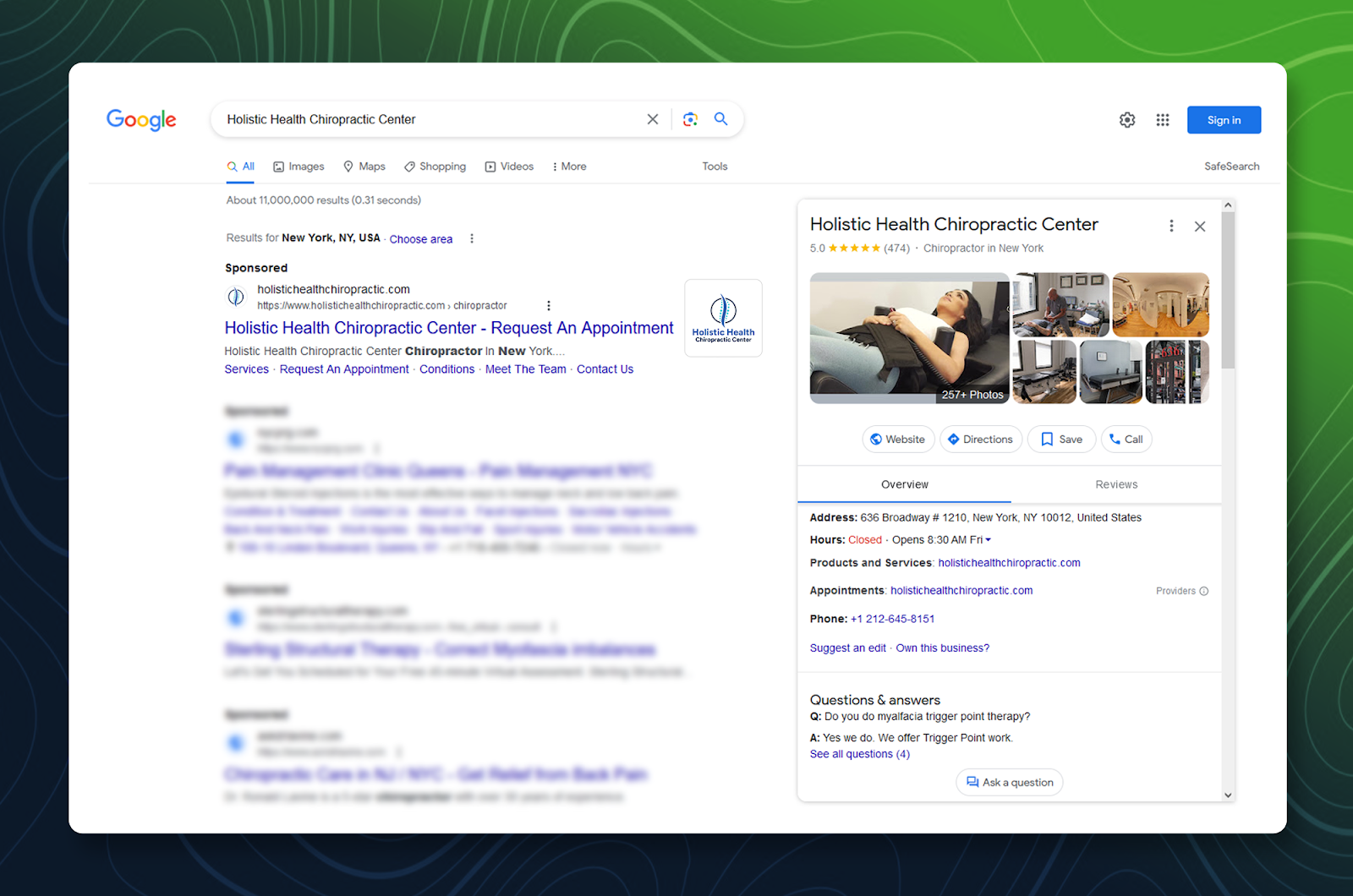Having a well-designed marketing plan for chiropractors is crucial for success. As the number of chiropractic practices rises, it becomes challenging to stand out and attract new patients. This makes having a strategic marketing plan all the more critical.
An effective chiropractic marketing plan goes beyond simply advertising your services. It is about creating a unique identity and building trust in your expertise.
But where do you start? How can you develop a marketing plan that sets you apart from competitors and resonates with your desired audience? This detailed guide serves as your roadmap to success. It outlines the essential strategies needed to create a robust chiropractic marketing plan.
ChiroCandy Marketing is your key to success when putting your practice on the map. With the help of our marketing plan for chiropractors, you can establish a strong presence in the digital world. We can help you attract new patients while retaining existing ones.
Contact us today to learn more about how our comprehensive marketing services can help you achieve your business goals.
Highlighting the Need for Chiropractic Marketing
Before diving into the specifics, it's crucial to understand why chiropractors need a plan in the first place. With more than 70,000 licensed chiropractors in the United States alone, competition is fierce and only expected to increase.
Moreover, with a growing emphasis on preventative care, individuals are turning to alternative treatments. This allows chiropractors to broaden their patient base and expand their business.
However, attracting and retaining patients can be challenging without effective chiropractic marketing strategies. A well-designed marketing plan sets your practice apart and highlights the value of chiropractic care.
Benefits of a Comprehensive Marketing Plan for Chiropractic Businesses
Establishes Your Unique Identity
A marketing plan allows you to define your unique identity and brand in the competitive market. This includes creating a memorable logo, tagline, and messaging that resonates with your target audience.
Builds Trust in Your Expertise
Marketing allows you to showcase your knowledge and expertise. Blogs, social media, and newsletters position you as a credible authority in chiropractic care. This helps in building trust and credibility with potential patients.
Attracts New Patients
A good marketing plan for chiropractors can help you reach new patients. Many people nearby may not know the benefits of chiropractic treatment or your clinic. With a chiropractic marketing plan, you can attract new patients and boost your revenue.
Retains Existing Patients
A marketing plan involves both attracting new patients and retaining existing ones. Engaging with current patients encourages them to keep seeking your services. It also convinces them to refer others to your chiropractic clinic.
Simply put, practical chiropractic marketing ideas give you an edge over competitors. It helps establish a thriving practice that attracts and retains patients for years.
Essential Components of a Chiropractic Marketing Plan
A comprehensive chiropractic marketing plan includes several key components. These components work together to create a powerful strategy for your chiropractic business.
Thorough Market Analysis
A successful chiropractic marketing plan begins with a thorough analysis of the market in which you are operating. This involves understanding the demographics and psychographics of your target audience.
Gaining a deep understanding of your market allows you to tailor your chiropractic marketing efforts. It also identifies potential opportunities and challenges in the market. This enables you to reach and resonate with your desired audience efficiently.
Competitor Analysis
Analyzing your competitors' marketing strategies is crucial to a marketing plan. This allows you to identify what sets you apart from others and capitalize on any gaps in the market that you can fill.
Competitive analysis enables you to create a unique identity for your chiropractic practice. This will help you to attract patients and foster loyalty.
Strong Brand Identity
A solid brand identity is essential in standing out and creating a memorable image for your practice. This includes defining your brand values, messaging, and visual elements such as logo and color scheme.
A consistent and cohesive brand identity can establish patient trust and position yourself as an expert.
Robust Online Presence
In today's digital age, having a solid online presence is vital for the success of any business. This includes having a:

- Professional Website,
- Active social media profiles and
- Positive online reviews.
It is crucial to regularly update and maintain these platforms to ensure they accurately portray your brand and services.
Effective Patient Relationship Management
Building and maintaining solid relationships with patients is crucial for practice growth. This involves:
- Providing exceptional customer service
- Personalized communication
- Actively seeking patient feedback
Prioritizing patient satisfaction and engagement fosters loyalty. It also helps in attracting new patients through positive word-of-mouth.
Essential Marketing Strategies for Chiropractors
A successful marketing plan for chiropractors incorporates a variety of strategies. These include:
Setting Clear Goals for Your Digital Marketing Plan
The foundation of any successful marketing plan for chiropractors is to set clear and achievable goals. Define what you want to accomplish with your marketing efforts:
- Increasing patient appointments
- Expanding your client base
- Enhancing your online presence.
Your chiropractic marketing plan hinges on these objectives. Clearly defining your goals will help you ensure that every strategy and tactic is aligned to achieve them.
Optimizing Your Online Presence with Search Engine Optimization (SEO)
SEO is the key to improving your Website's visibility in search engines. A well-crafted chiropractic marketing plan is incomplete without effective SEO strategies.
These include optimizing your Website content, meta descriptions, and title tags. SEO enables your Website to rank higher in search engine results pages (SERPs). This, in turn, helps to attract and convert them into patients.

To boost your SEO efforts, make sure to:
- Optimize your Website structure.
- Incorporate relevant keywords.
- Provide valuable content.
SEO is the key to ensuring your chiropractic practice stands out in the competitive healthcare landscape.
ChiroCandy provides expert SEO services for your chiropractic Website. Learn more about our SEO strategies and get started with us today.
Leveraging Email Marketing Effectively
79 percent of marketers place email marketing in their top 3 marketing channels. Email marketing is one of the most potent digital marketing tools in chiropractor marketing plans.
It is an effective way to connect with patients, build trust, and promote your services. To ensure your email campaigns are successful:
- Personalize your messaging.
- Segment your email list based on specific criteria.
- Provide valuable content such as health tips, promotions, and relevant updates.
Send out newsletters and promotions, all tailored to the interests of your patients. A well-planned email strategy can help you build your patient base and drive traffic to your Website.
Harnessing the Power of Social Media
Social media is a powerful platform for reaching and engaging with potential patients. It is an excellent way to showcase your practice, share success stories, and build relationships with your audience.
To make the most of social media in your chiropractic marketing plan:
- Choose the right platforms for your target audience.
- Share valuable content that educates and entertains.
- Interact with your followers regularly.
Social media platforms are fertile ground for connecting with your audience. A relevant social media presence can help you build a positive online reputation and drive more Website traffic.
Utilizing the Power of Video Marketing & Testimonial Videos
Video marketing is a powerful chiropractic marketing strategy. It lets you showcase your practice and services visually, making it more engaging and memorable for viewers.
Consider creating video content such as:
- Educational videos on chiropractic care.
- Virtual tours of your practice.
- Testimonial videos from satisfied patients.
These videos engage your audience personally, making your practice more relatable. This can enhance your online presence and attract more patients.
Content Marketing for Chiropractors
Content marketing is a crucial aspect of any successful chiropractic marketing plan. Creating valuable and informative content helps establish yourself as an expert in your field. Consider incorporating the following types of content into your chiropractor marketing plan:
- Blogs and articles on relevant topics.
- E-books or guides on specific health concerns.
- Social media posts and graphics.
Optimize your content and include relevant calls to action to drive conversions. Video and content marketing work hand in hand to create a well-rounded marketing strategy for chiropractors.
Managing Your Google Business Profile
Your Google Business Profile is essential to your online presence as a chiropractor. It provides vital information about your practice to potential clients. GBP appears on Google Maps and Google search results, and it further establishes your business’s credibility.

To effectively manage your Google Business Profile:
- Claim and verify your listing.
- Update accurate contact information and hours of operation.
- Encourage patients to leave reviews.
Local businesses with complete and accurate GBPs are more likely to appear in local search results.
Pay-Per-Click Advertising for Increased Traffic
PPC advertising, such as Google Ads and Facebook Ads, is valuable in your chiropractic marketing plan.
Consider this: PPC returns $2 for every $1 spent. That means that for every dollar you invest in PPC, you can expect to get double back in revenue.
PPCs allow you to target specific keywords and demographics. This ensures that your ads are seen by potential patients who are actively searching for chiropractic services.
To make the most of PPC advertising:
- Research relevant keywords and incorporate them into your ad copy.
- Target specific demographics based on age, location, and interests.
- Monitor and adjust your campaigns regularly for optimal results.
PPC advertising can be cost-effective in driving targeted traffic to your website and attracting potential patients. You can achieve a substantial return on investment by monitoring and optimizing your campaigns.
Partnering with other Healthcare Providers
Collaborating with other healthcare providers can help you increase patient referrals. Consider partnering with health professionals who share a similar target audience and values.
You could also offer services for their patients, such as discounts or special treatments. This way, they may be more likely to refer them to your practice and keep them returning.
To effectively partner with other healthcare providers:
- Attend local events or conferences to connect with other professionals.
- Offer to provide educational presentations or health and wellness lectures.
- Refer patients to other providers and encourage them to do the same.
Your healthcare network can help you establish credibility and increase your patient base. It will also enhance your online presence through mutual support and referrals. Working together will enable you to provide comprehensive care to your patients.
Encouraging Patient Reviews and Referrals
Collecting positive patient reviews and referrals can be beneficial to your practice. Encourage your patients to leave reviews on platforms like Google, Yelp, and Healthgrades. These positive reviews can help attract new patients and nurture client relationships.
Did you know 77% of patients rely on online reviews when searching for a new doctor? It's imperative to leverage this valuable resource.
Consider implementing a referral program to reward patients who refer others to your practice. This can create a strong sense of community and loyalty among your patients while also helping to grow your practice.
Measuring Your Success with Data Analytics
Data analytics is a crucial aspect of any successful chiropractic marketing plan. It allows you to track and measure the effectiveness of your strategies. This helps to make data-driven decisions for future marketing efforts. To achieve this, utilize tools such as Google Analytics to track:
- Website traffic and conversions.
- Social media engagement and reach.
- PPC advertising performance.
Continuously analyzing your data will help you optimize your strategies for maximum impact. It will also help you understand your audience and make informed decisions for future marketing campaigns.
In conclusion, an effective chiropractic marketing plan should incorporate various strategies. The aim should be to reach and engage with a maximum number of potential patients.
Video marketing, content marketing, and PPC advertising can help attract new patients. Managing your GBP, encouraging patient reviews, and analyzing data are crucial for success.
FAQs
Why Is Digital Marketing Important for Chiropractors?
In today's digital age, online presence is crucial for chiropractic practice. Digital marketing provides a cost-effective way to reach potential patients and engage with them. It also allows for precise targeting and tracking of results.
How Can Chiropractic Marketing Help in the Growth of My Practice?
A well-designed marketing plan attracts new patients and helps retain existing ones. This leads to increased revenue and growth for your chiropractic practice. Additionally, marketing can help build a positive reputation in the community. This leads to more referrals and patient loyalty.
What should be included in a chiropractic marketing plan template?
A chiropractic marketing plan template should include the following:
- A detailed analysis of the target audience
- Goals and objectives
- Strategies for reaching and engaging potential patients
- Budget allocation
- Methods for measuring success.
What Elements Should Be Included in a Marketing Plan Chiropractic Office?
A comprehensive marketing plan for a chiropractic office should encompass critical components such as defining your target audience, setting clear marketing objectives, conducting a competitive analysis, selecting appropriate marketing channels (online and offline), crafting compelling messaging, setting a budget, and establishing a timeline for implementation and evaluation.
Can You Provide an Example of a Chiropractic Marketing Plan?
A chiropractic marketing plan typically includes strategies for patient acquisition and retention. It may include online marketing efforts like website optimization, social media engagement, content creation, email campaigns, and offline strategies like community outreach and networking.
How Can I Create a Monthly Marketing Plan for Chiropractors?
Creating a monthly marketing plan for your chiropractic practice involves:
- Setting specific monthly goals.
- Outlining promotional activities (e.g., special offers, workshops, or health tips).
- Determining which marketing channels to utilize.
- Allocating a budget.
- Assigning responsibilities.
Regularly assess the plan's effectiveness and adjust as needed to stay on track and achieve your practice's growth objectives.
Can you share a chiropractic marketing plan sample?
Yes, an example of a chiropractic marketing plan sample could look like this:
Target Audience: Individuals seeking natural and holistic healthcare options.
Goals and Objectives: Increase patient base by 20% within six months.
Budget: $1000 per month.
Tactics and Strategies:
- video marketing
- content marketing
- PPC advertising
- partnerships with other healthcare providers
Metrics for Tracking Success:
- Website Traffic
- conversions
- social media engagement
- patient referrals.
Why is it essential to have a monthly marketing plan for a chiropractic office?
A monthly marketing plan allows chiropractic offices to consistently reach out to potential patients and keep the business visible in the market. It also provides an opportunity to evaluate and adjust marketing strategies based on data and results.




